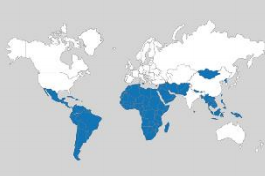When I played my role in the policy exercise, I felt almost left out in a way. Because my group was the UN, we didn’t have to negotiate too much with other nations because we were already doing as much as possible to cut down our emissions and we were giving out a generous amount of money. However, we did have some negotiations with the developing nations and got them to agree to use our funding with oversight from us.
In the first round, our claims did not really change because we were putting forth a massive effort to reduce emissions. The second round however, is where things began to change. We ended up donating $50 billion more than before and negotiated with the United States to give at least some money. They ended up only giving $12 billion to be used to help fight climate change. The biggest negotiation that we made successful also came in the second round of negotiating. We were able to get the developing nations to use our funding, under the condition that we could oversee the implementation and use of our funds. My reactions to the United States’ position changed but only slightly. In the first round they pledged to give only $17.76 which is just terrible compared to how much money they could have spent. In the second round, they raised that to $12 billion which I still believe is very little for them because they are currently one of the largest carbon emitters.
Our group changed our ideas because we originally thought that all of the developed nations would be willing to give money to help the less developed nations reduce their emissions, but we were mistaken. Our ideas then changed to convincing the developed nations to help while we were still giving tons of money in aid.
This change came about because of the lack of funds from some of the nations with the largest economies such as the US and China. Those two nations could have given significantly more money. It took a lot of convincing to get the US to give the amount that they ended up giving.
In the end, I believe that emissions can be cut, however, there will have to be a massive push from political leaders to make any significant changes. If there are no consequences for high emissions, then nothing will really change. Along with this, political leaders are the only ones who can access enough money and allocate it in their budget. Without enough funding, the cutting of emissions is only a dream.
One of the major costs for the implementation of emission reducing proposals was the fact that we, the EU, had to give out so much money. That money could have been used to assist ourselves and reduce our emissions, but we decided to give it to those who needed it more than us. One of the major barriers was the US being stubborn and only focusing on themselves and convincing the developing nations that they needed our oversight if they were to use our funds. Eventually both agreed, but it was difficult to get to that point.
We can catalyze change in the US by promoting recycling, compostable materials, and alternative energy. These changes will reduce the amount of carbon emissions because they will eventually replace the current emission spewing methods. Factories could be run on solar, wind, or water power, cars could all be electric and give off zero emissions, and the reusing and composting of materials would reduce the amount of products produced in factories and limit the amount of waste that is left over. These changes would launch the US into the direction of reducing its carbon emissions and set an example for the rest of the world to follow.

